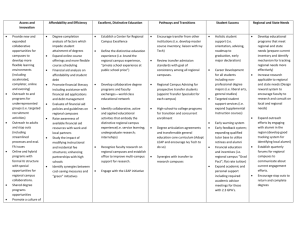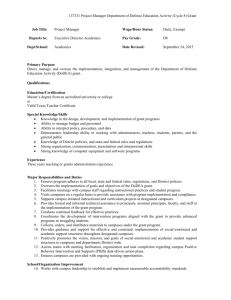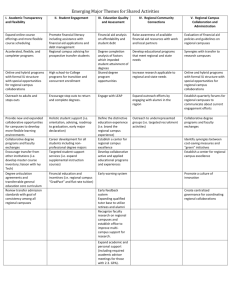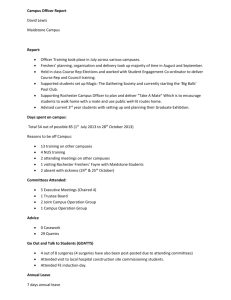Adobe Photoshop PDF
advertisement
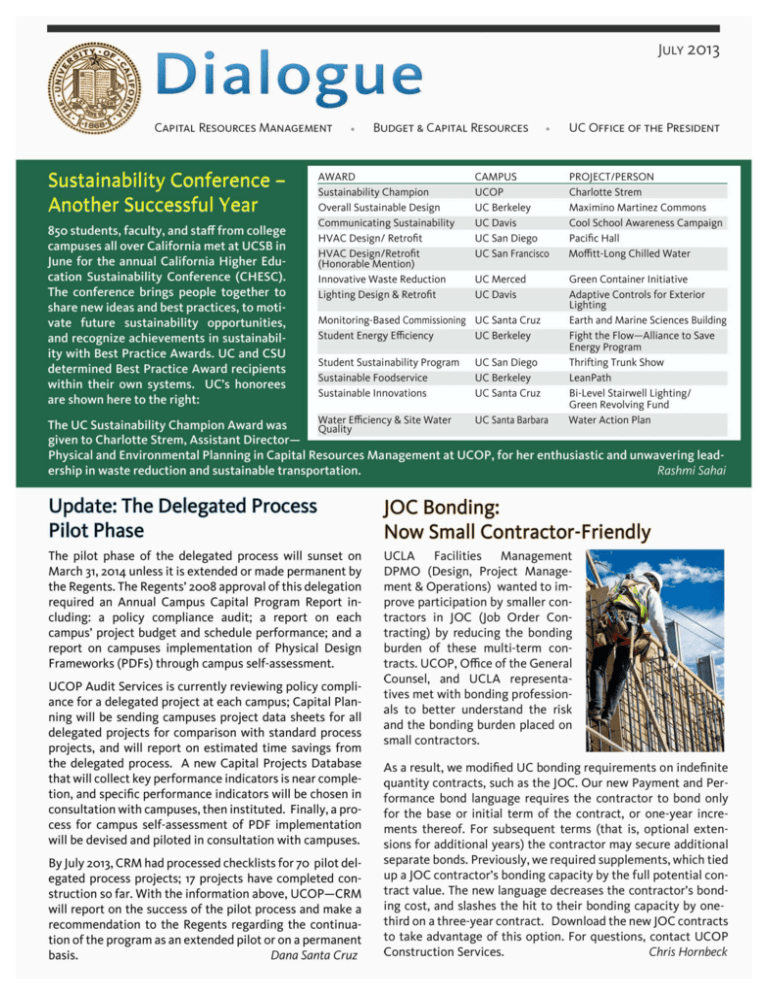
jULY 2013 Dialogue CAPITAL RESOURCES MANAGEMENT Sustainability ConferenceAnother Successful Year 8so students, faculty, and staff from college campuses all over California met at UCSB in june for the annual California Higher Education Sustainability Conference (CHESC). The conference brings people together to share new ideas and best practices, to motivate future sustainability opportunities, and recognize achievements in sustainability with Best Practice Awards. UC and CSU determined Best Practice Award recipients within their own systems. UC's honorees are shown here to the right: BUDGET & CAPITAL RESOURCES AWARD Sustainability Champion Overall Sustainable Design Communicating Sustainability HVAC Design/ Retrofit HVAC Design/Retrofit (Honorable Mention) Innovative Waste Reduction Lighting Design & Retrofit CAMPUS UCOP UC Berkeley UC Davis UC San Diego UC San Francisco PROJECT /PERSON Charlotte Strem Maximino Martinez Commons Cool School Awareness Campaign Pacific Hall Moffitt-Long Chilled Water UC Merced UC Davis Green Container Initiative Adaptive Controls for Exterior Lighting Earth and Marine Sciences Building Fight the Flow-Alliance to Save Energy Program Thrifting Trunk Show Lean Path Bi-Level Stairwell Lighting/ Green Revolving Fund Water Action Plan Monitoring-Based Commissioning UC Santa Cruz Student Energy Efficiency UC Berkeley Student Sustainability Program Sustainable Foodservice Sustainable Innovations UC OFFICE OF THE PRESIDENT UC San Diego UC Berkeley UC Santa Cruz UC Santa Barbara The UC Sustainability Champion Award was • . given to Charlotte Strem, Assistant DirectorPhysical and Environmental Planning in Capital Resources Management at UCOP, for her enthusiastic and unwavering leadership in waste reduction and sustainable transportation. Rashmi Sahai Update: The Delegated Process Pilot Phase JOC Bonding: Now Small Contractor-Friendly The pilot phase of the delegated process will sunset on March 31, 2014 unless it is extended or made permanent by the Regents. The Regents' 2008 approval of this delegation required an Annual Campus Capital Program Report including: a policy compliance audit; a report on each campus' project budget and schedule performance; and a report on campuses implementation of Physical Design Frameworks (PDFs) through campus self-assessment. UCLA Facilities Management DPMO (Design, Project Management & Operations) wanted to im prove participation by smaller con tractors in JOC Uob Order Con tracting) by reducing the bonding burden of these multi-term con tracts. UCOP, Office of the General Counsel, and UCLA representa tives met with bonding profess ion als to better understand the risk and the bonding burden placed on small contractors. UCOP Audit Services is currently reviewing policy compliance for a delegated project at each campus; Capital Planning will be sending campuses project data sheets for all delegated projects for comparison with standard process projects, and will report on estimated time savings from the delegated process. A new Capital Projects Database that will collect key performance indicators is near completion, and specific performance indicators will be chosen in consultation with campuses, then instituted. Finally, a process for campus self-assessment of PDF implementation will be devised and piloted in consultation with campuses. By July 2013, CRM had processed checklists for 70 pilot delegated process projects; 17 projects have completed construction so far. With the information above, UCOP-CRM will report on the success of the pilot process and make a recommendation to the Regents regarding the continuation of the program as an extended pilot or on a permanent basis. Dana Santa Cruz As a result, we modified UC bonding requirements on indefinite quantity contracts, such as the JOC. Our new Payment and Performance bond language requires the contractor to bond only for the base or initial term of the contract, or one-year increments thereof. For subsequent terms (that is, optional exten sions for additional years) the contractor may secure additional separate bonds. Previously, we required supplements, which tied up a JOC contractor's bonding capacity by the full potential con tract value. The new language decreases the contractor's bonding cost, and slashes the hit to their bonding capacity by onethird on a three-year contract. Download the new JOC contracts to take advantage of this option. For questions, contact UCOP Construction Services. Chris Hornbeck Dialogue jULY 2013 KEY DATES AUGUST - - - - - - - - - New Storm Water Regulations in Effect Stringent new storm water regulations were adopted by the State Water Resources Control Board, and cover all UC campuses via the Municipal Separate Storm Sewer Systems (MS4) Phase II permit. Projects that build or replace as little as 2,500 square feet of impervious area (the roof area of a one-story house) must drain no more water off the site after construction than before construction. Campus Environment, Health and Safety staff can tell you more. These regulations require attention by those who budget, site, design, construct and operate facilities. Key issues for: • BUDGET PLANNERS- What is the cost of equipment potentially needed to handle storm water? (E.g., underground holding tanks.) Is it included in the budget? • SITE PLANNERS and DESIGN PROFESSIONALS- Volume of storm water involved. How will it be handled? Is the soil percolation rate adequate? Required area for bioswales or underground tanks available? Will storm water solutions affect adjacent projects and areas? • CEQA ENVIRONMENTAL PLANNERS- Environmental document should address all the issues described above, plus the amount of excavation and associated truck trips. • CONSTRUCTION- Cost and schedule impacts for all issues described above. • OPERATIONS- Ongoing O&M of underground tanks or bioswales? For more information please contact your campus EH&S office. Charlotte Strem 6 TM1 Capital Projects Database 'Refresher' Training UCOP 23 DEADLINE FOR MAJOR CAP REPORTING 2012-13 SEPTEMBER 4 OAKLAND s-STAR (ON (ENTER 11 UCSD ill IPI . ill IPI 17-19 BIM- BUILDING INFORMATION MODELING BIM- BUILDING INFORMATION MODELING REGENTS MEETING UCSF MISSION BAY Updated Relocation Pol icy UC is subject to Federal and State relocation regulations any time UC acquires or master leases property with third party tenancies that the University does not renew. In 1975, UC adopted its own policy modeled on California's relocation regulations. The University's updated Relocation Assistance Act Policy for Real Estate Acquisitions and Leases ("Policy") was recently approved by The Regents and incorporates changes that have been made in the State regulatory scheme. The implementation of the Policy has been delegated to the Chancellors et al. While the Policy is generally more rigorous than Federal regulations, campuses should consult with the Office of General Counsel on Federal requirements if there is any Federal component to your project. For acquisitions involving multiple private tenants or any residential tenants, it is advisable to retain an independent consultant specializing in the arcane area of relocation law to prepare a relocation plan and to follow up with displaced parties; such consultants know the State regulations on which UC's policy is based. Note especially that tenants in UC-acquired and -leased properties not offered renewal at lease expiration are entitled to relocation assistance. It is not only eminent domain acquisitions that trigger these requirements-any UC acquisition or master lease of property with an existing tenant is subject to the Policy. Gordon Schanck New Mandatory Energy Code Requirements .~ · CODE CORNER The 2013 California Energy Code includes significant changes that take effect six months from now. Among these changes are new mandatory requirements and increased stringency in some existing mandatory requirements. These mandatory measures are required of every project, regardless of whether a project follows the prescriptive or the performance path for the other measures of the energy code. Following is a list of some of the more significant mandatory measures for non-residential buildings. For a complete list of residential and non-residential mandatory measures, see: http://www.energy.ca.gov /title24/2013standards/ Requirements for computer data centers MANDATORY MEASURES MECHANICAL SYSTEMS BUILDING ENVELOPES Increased cool roof reflectance New maximum building envelope air leakage rate (commissioning required) Window glazing reduced solar gain and increased light transmittance New minimums for wall and roof insulation LIGHTING Controllable ballasts, increased intermediate lighting levels, demand response controls Occupancy sensors in library stack aisles Occupancy and daylight sensors in parking garages SOLAR READINESS Provisions for building readiness to install solar electric or water heating systems PROCESS LOADS Ventilation controls for commercial kitchens Ventilation controls for parking garages Laboratory exhaust VAV and heat recovery Added requirements for fan control and integrated economizers Reduced ability for HVAC reheat Commercial boiler combustion controls Acceptance testing for HVAC sensors and controls Added credit for evaporative systems that meet certain criteria Fault detection for temperature, economizers, dampers, and outdoor air ELECTRICAL POWER DISTRIBUTION Demand responsive controls Disaggregation of electrical circuits for larger size services Receptacle controls to shut off task lighting and other plug loads when unoccupied COMMISSIONING Design-phase commissioning (early review of design intent; documentation) Two-sten performance rating for whole-building performance ("design" and "as-built" ratings) Catherine l<niazewycz For corrections, updates or future contributions please contact: MICHAEL.LINDER@UCOP.EDU



